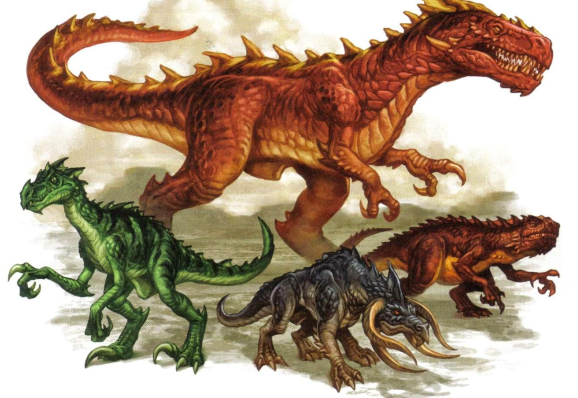Let's Read the 4e Monster Manual 2: Drakes

This is part of a series! Go here to see the other entries.
Drakes make their debut on the first 4e Monster Manual, and this entry brings us a few more of them. They remain a popular choice of animal for domestication but the intro text mentions they retain a wild side.
Bloodseeker Drake
These expert trackers were included in the Monster Vault, so we already looked at them here.
Horned Drake
In the wild, horned drakes are pack predators who spend most of the day sleeping and basking in the sun, going out to hunt at night. They have an excellent instinct for teamwork, and a pack of them is able to take down much larger prey.
I imagine that, when domesticated, they make stronger alternatives to the bog-standard guard drake, treating their handlers as part of the pack.
The Numbers
Horned Drakes are Medium Natural Beasts and Level 5 Skirmishers with 63 HP. They have low-light vision and a speed of 6.
This drake’s basic attack is a bite that does standard physical damage and allows the creature to shift 2 squares on a hit. The Pack Movement reaction also allows them to shift 2 squares when an enemy adjacent to them is hit by a melee attack. This makes them great a setting up flanks with their fellow drakes or with their handlers.
The drake can also make a Goring Horns attack, which does high physical damage and knocks prone on a hit. It also has a +1 attack bonus over the basic attack, which indicates to me that it’s meant to be a charge.
So, these drakes are set up charge an enemy, then surround and run circles around it.
Scytheclaw Drake
Another species of pack predator, scytheclaws inhabit forests and grasslands. They are known for their cunning and for their devious tactics. If you see one scytheclaw, odds are there are two or three others approaching you from behind.
In other words, they’re Jurassic Park raptors!
The Numbers
Scytheclaws are Medium Natural Beasts and Level 10 Skirmishers with 105 HP, which explains why the Jurassic Park protagonists had such trouble with them. Their ground speed is an amazing 10.
Their basic attack is the titular Scytheclaw, which deals physical damage and knocks the target prone. If used against an already prone target, it hits harder and inflicts 5 ongoing damage (save ends).
When the drake hits with its basic attack, it can immediately use Springing Step (free action; recharge 4-6), which allows it to jump 8 squares and attack someone else at the end of the jump. This doesn’t provoke opportunity attacks from the target of the original attack, making it safe to move away from most PCs.
If a prone enemy within reach tries to get up, its Overwhelming Attacker trait allows it to make an opportunity attack against that enemy. If this hits, the target remains prone.
Scytheclaws are therefore set up to bounce between PCs while knocking them prone, and they will absolutely kick you when you’re down.
Fang Titan Drake
If you include the Raptors, you almost certainly have to include the T-Rex as well. And sure enough, here it is. The largest species of drake, few creatures other than dragons can pose much of a treat to them. Mostly solitary, they claim large territories and chase away all other big predators, so ironically creatures beneath the fang titan’s notice end up enjoying a measure of protection.
In most settings, such a creature would be impossible to domesticate, but in D&D’s implied setting some sapients such as giants can manage it due to not being that much smaller than them.
The Numbers
Fang Titans are Huge Natural Animals and Level 18 Elite Controllers with 348 HP. Their ground speed is 8.
Their basic attack is a humongous bite that can target one or two creatures, dealing physical damage and dazing them (save ends). They can also grab one of the targets on a hit.
They can also attack with a Tail Sweep (close burst 2 vs. Reflex; recharge 4-6) that does high physical damage and knocks prone. Their Furious Roar works exactly like a dragon’s Frightful Presence, and when they’re bloodied they recharge it and use it immediately as a free action.
Sample Encounters And Final Impressions
Two sample drake encounters in this entry:
-
Level 3: A lizardfolk hunting party with a pair of bloodseeker drakes.
-
Level 19: A quartet of fire giants and their pet fang titan.
As I mentioned during my reading of the MM/MV, I love drakes and more of them are always welcome. For many of them, it’s also easy to “de-skin” them as dinosaurs if you’re so inclined, but making them a distinct type of creature also frees the authors (and you!) from having to adhere to best paleontological practices.